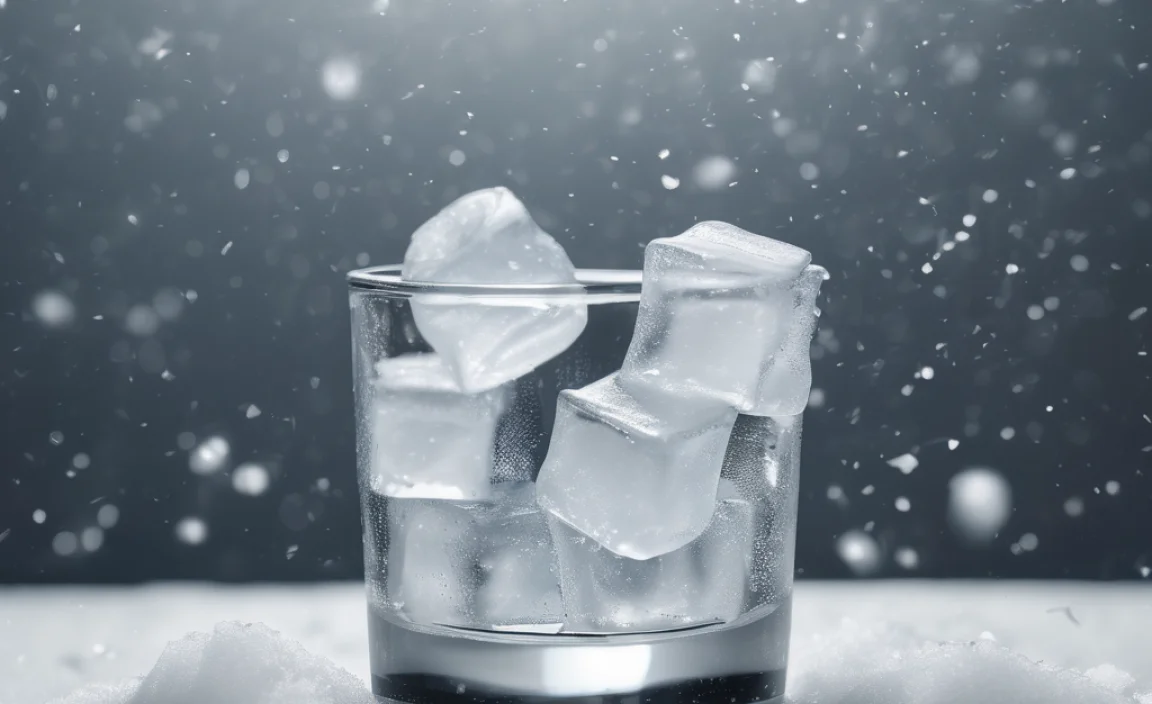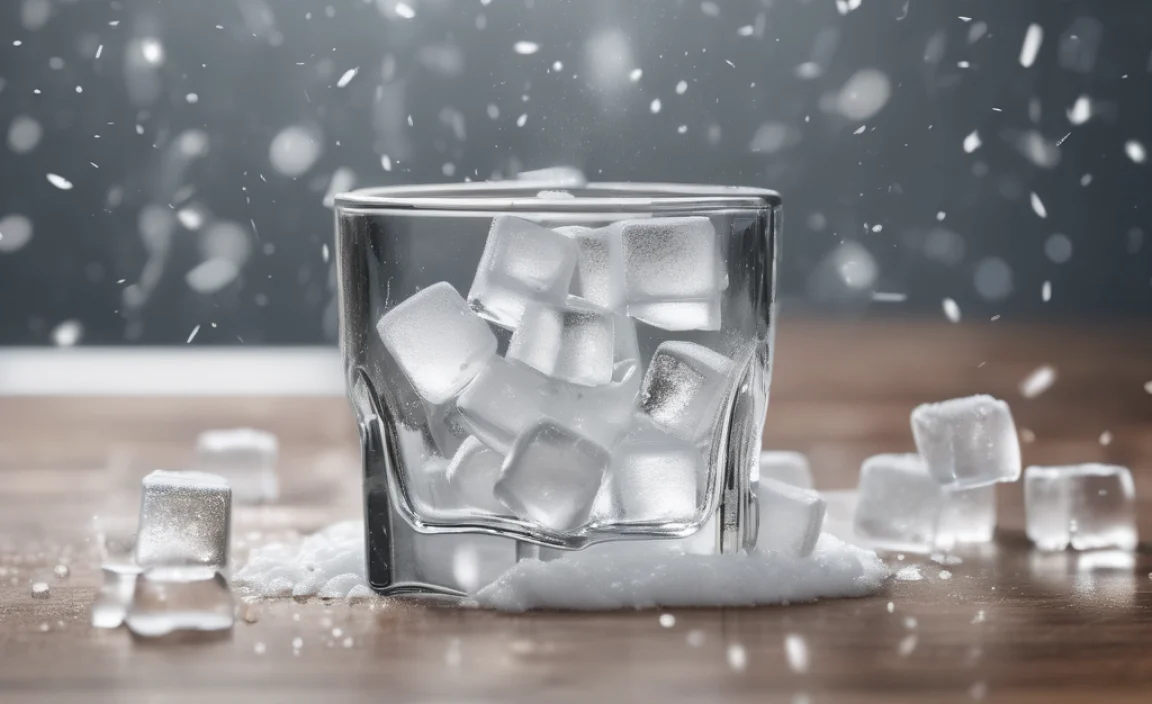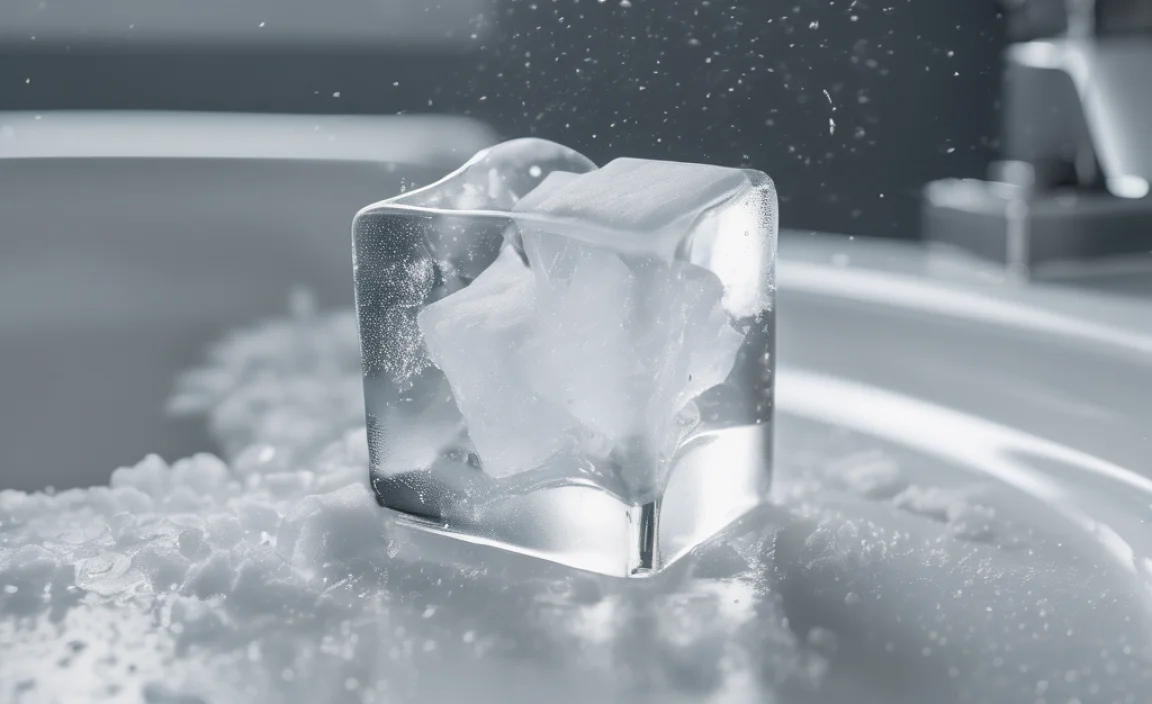Flushing ice cubes down the toilet will not make it snow. The amount of ice is far too small to affect weather patterns. Snow forms due to large-scale atmospheric conditions like temperature and moisture, not from local actions like flushing ice.
Ever heard that flushing ice cubes down the toilet makes it snow? It’s a fun idea, right? But does it actually work? Many folks wonder if something as simple as ice can change the weather. Let’s dive into the truth behind this myth. We’ll look at why snow happens and what it really takes to make it snow. Get ready to bust some myths and learn some cool facts!
Understanding How Snow Forms

To understand why flushing ice cubes won’t cause snow, let’s first look at how snow actually forms. It all starts high up in the atmosphere.
The Basics of Snow Formation
Snow forms when water vapor in the air freezes. Here’s a quick rundown:
- Water Vapor: Water evaporates from lakes, rivers, and oceans, turning into water vapor.
- Cold Temperatures: The upper atmosphere needs to be very cold, usually below freezing (32°F or 0°C).
- Ice Nuclei: Water vapor needs something to freeze onto, like tiny particles of dust or pollen. These are called ice nuclei.
- Snow Crystals: As water vapor freezes onto these particles, it forms ice crystals. These crystals join together to form snowflakes.
These snowflakes then fall to the ground. If the ground temperature is also cold enough, the snow will stick around and accumulate.
Large-Scale Weather Patterns
Snow formation isn’t just about having cold air and water vapor. Large-scale weather patterns play a big role.
- Moisture: There needs to be a lot of moisture in the air. This often comes from large bodies of water like oceans and lakes.
- Lifting Mechanism: The air needs to rise. This can happen due to fronts (like cold fronts), low-pressure systems, or mountains forcing the air upwards.
- Atmospheric Stability: The atmosphere needs to be stable enough for the snow to form and fall without melting.
All these factors need to come together to create a snowstorm. It’s a complex process involving a lot of energy and water.
Why Flushing Ice Cubes Won’t Work

Now that we know how snow forms, let’s look at why flushing ice cubes won’t make it snow. It boils down to scale and energy.
The Scale Problem
The amount of ice you flush down the toilet is tiny compared to the amount of water needed to create a snowstorm. Think about it:
- Snowstorms Need a Lot of Water: A single snowstorm can drop millions or even billions of gallons of water as snow.
- Ice Cubes Are Insignificant: A tray of ice cubes might contain a few cups of water. This is a tiny fraction of what’s needed for snow.
To put it in perspective, imagine trying to fill a swimming pool with an eyedropper. It would take forever, and you wouldn’t make much of a difference. Flushing ice cubes is similar – the amount of water is just too small to have any noticeable effect.
The Energy Problem
Snow formation requires a lot of energy. This energy comes from the atmosphere and the sun. Flushing ice cubes doesn’t add any significant energy to the system.
- Atmospheric Energy: Snowstorms are driven by large-scale weather systems that have a lot of energy. This energy is what causes the air to rise, cool, and form snow.
- Ice Cubes Don’t Add Energy: Ice cubes are cold, but they don’t add any significant energy to the atmosphere. In fact, they absorb a little bit of heat as they melt.
Think of it like trying to power a city with a small battery. The battery might be useful for a small device, but it can’t provide enough energy to power a whole city. Similarly, ice cubes can’t provide enough energy to create a snowstorm.
Local vs. Global Effects
Flushing ice cubes might slightly cool the water in your local sewer system. But this effect is very localized and doesn’t extend to the atmosphere.
- Local Effects: The ice cubes melt quickly and mix with the water in the pipes. This might slightly lower the water temperature in the immediate area.
- No Global Effect: This small change in temperature doesn’t affect the atmosphere or the weather patterns that cause snow.
The atmosphere is a huge, complex system. Small, local actions like flushing ice cubes simply don’t have the power to change it.
Scientific Perspective

Scientists study weather patterns and climate using complex models and data. These models take into account many factors, such as temperature, humidity, wind, and solar radiation. Flushing ice cubes isn’t even on the radar.
Meteorological Models
Meteorological models are used to predict the weather. These models are based on the laws of physics and chemistry and take into account a vast amount of data.
- Complex Calculations: These models perform complex calculations to simulate the behavior of the atmosphere.
- Large Datasets: They use data from weather stations, satellites, and other sources to get an accurate picture of what’s happening.
- No Ice Cube Factor: Flushing ice cubes is not a factor that’s considered in these models because it’s simply too insignificant to have any effect.
Climate Studies
Climate scientists study long-term weather patterns and trends. They look at things like global temperature, sea levels, and precipitation patterns.
- Long-Term Trends: Climate studies focus on long-term changes in the Earth’s climate.
- Large-Scale Factors: They consider factors like greenhouse gas emissions, solar activity, and ocean currents.
- Ice Cubes Are Irrelevant: Again, flushing ice cubes is not a factor that’s considered in climate studies because it’s too small to have any impact on the global climate.
Debunking the Myth

So, where did this myth come from? It’s hard to say for sure, but it’s likely a combination of wishful thinking and misunderstanding of how weather works.
Wishful Thinking
Many people love snow and wish it would snow more often. The idea that you could make it snow by simply flushing ice cubes is appealing.
- Fun Idea: It’s a fun and whimsical idea that captures the imagination.
- Simple Solution: It suggests a simple solution to a complex problem (wanting more snow).
However, just because an idea is appealing doesn’t mean it’s true. It’s important to rely on scientific evidence and understanding to separate fact from fiction.
Misunderstanding Weather
Many people don’t fully understand how weather works. They may not realize the scale of the atmospheric processes that cause snow.
- Complex Systems: Weather is a complex system involving many interacting factors.
- Scale Matters: The scale of these factors is enormous compared to everyday actions like flushing ice cubes.
Education and awareness are key to dispelling myths about weather and climate. The more people understand about how these systems work, the less likely they are to believe in unfounded claims.
Fun Facts About Snow

While flushing ice cubes won’t make it snow, there are still plenty of fascinating facts about snow to explore.
Snowflake Formation
No two snowflakes are exactly alike. Each snowflake is unique due to the way it forms in the atmosphere.
- Unique Crystals: The exact shape of a snowflake depends on the temperature and humidity of the air it passes through.
- Symmetry: Snowflakes have a six-sided symmetry because of the way water molecules arrange themselves when they freeze.
The next time you see snow, take a close look at the snowflakes. You’ll be amazed by the intricate and beautiful designs.
Snow and Temperature
Snow can form at temperatures slightly above freezing. This is because the air temperature is not the only factor that determines whether snow will fall.
- Evaporative Cooling: As snowflakes fall through the air, they can cool the air around them through evaporation.
- Wet Snow: This can lead to “wet snow,” which is heavy and contains a lot of water.
The temperature of the ground also plays a role. If the ground is warm, the snow may melt as soon as it hits the surface.
Snow and Climate Change
Climate change is affecting snow patterns around the world. In many areas, snow is melting earlier in the spring and arriving later in the fall.
- Shorter Snow Season: This can have significant impacts on water resources, ecosystems, and winter recreation.
- Changes in Precipitation: Climate change can also lead to changes in the amount and type of precipitation, with some areas experiencing more rain and less snow.
Practical Ways to Enjoy Snow
While you can’t make it snow by flushing ice cubes, there are plenty of other ways to enjoy the snow when it does fall.
Outdoor Activities
Take advantage of the snowy weather by engaging in outdoor activities.
- Skiing and Snowboarding: Hit the slopes for some downhill fun.
- Snowshoeing and Cross-Country Skiing: Explore the winter landscape at a slower pace.
- Sledding and Tubing: Enjoy a thrilling ride down a snowy hill.
- Building a Snowman: Get creative and build a snowman with friends and family.
- Having a Snowball Fight: Engage in a friendly snowball fight for some active fun.
Indoor Activities
If it’s too cold to be outside, there are still plenty of ways to enjoy the snow from indoors.
- Watching the Snow Fall: Curl up by the window with a warm drink and watch the snow fall.
- Reading a Book: Enjoy a good book by the fireplace while the snow falls outside.
- Playing Board Games: Gather friends and family for a fun game night.
- Cooking and Baking: Try out some new recipes and enjoy a warm meal or dessert.
- Crafting: Get creative with some winter-themed crafts.
Table: Factors Affecting Snowfall
| Factor | Description | Impact on Snowfall |
|---|---|---|
| Temperature | The air temperature needs to be at or below freezing (32°F or 0°C) for snow to form. | Critical for snow formation. Warmer temperatures can cause snow to melt. |
| Moisture | Sufficient moisture in the air is needed for water vapor to condense and form snow crystals. | Essential. Without enough moisture, snow cannot form. |
| Ice Nuclei | Tiny particles like dust or pollen that water vapor can freeze onto. | Necessary for initiating the formation of snow crystals. |
| Atmospheric Stability | Stable atmospheric conditions allow snow to form and fall without melting. | Important for snow to reach the ground. Unstable conditions can cause melting. |
| Lifting Mechanism | A process that causes air to rise, cool, and condense, such as fronts or mountains. | Needed to lift moist air to higher altitudes where it can cool and form snow. |
List: Steps to Prepare for a Snowstorm
- Monitor Weather Forecasts: Stay informed about potential snowstorms by checking weather forecasts regularly.
- Stock Up on Supplies: Ensure you have enough food, water, and other essential supplies to last for several days.
- Prepare Your Home: Insulate pipes, clear gutters, and trim tree branches to prevent damage from heavy snow.
- Have Emergency Equipment Ready: Keep a snow shovel, ice melt, and a generator on hand in case of power outages.
- Plan for Transportation: Make alternative transportation arrangements in case roads become impassable due to snow.
External Resources
- National Weather Service – Official source for weather forecasts and information.
- National Snow and Ice Data Center (NSIDC) – Provides data and information about snow and ice.
FAQ: Common Questions About Snow
Q: Can cloud seeding make it snow?
A: Yes, cloud seeding can sometimes increase snowfall. It involves spreading substances into clouds to encourage ice crystal formation. However, it requires specific weather conditions and isn’t always effective.
Q: What is the coldest temperature at which snow can form?
A: Snow can form at very cold temperatures, even as low as -40°F (-40°C). The key factor is having enough moisture in the air.
Q: Does altitude affect snowfall?
A: Yes, higher altitudes tend to receive more snowfall. This is because temperatures are generally colder at higher elevations, and air is forced to rise and cool, leading to snow formation.
Q: How much snow is needed to cancel school?
A: The amount of snow needed to cancel school varies by location. It depends on factors like local infrastructure, snow removal capabilities, and the safety of students and staff. Typically, several inches of snow or hazardous conditions can lead to school closures.
Q: Why is snow white?
A: Snow appears white because of the way light interacts with the ice crystals. The crystals scatter all colors of light equally, resulting in a white appearance.
Q: Is it true that animals act differently before it snows?
A: Yes, some animals exhibit changes in behavior before it snows. Birds may migrate to warmer areas, and mammals may seek shelter or build up their food reserves in anticipation of the storm.
Q: What makes some snow “good for packing” while others don’t?
A: Snow that is good for packing typically has a higher moisture content and is closer to the freezing point. This allows the snow crystals to stick together more easily, making it ideal for building snowmen or snow forts.
Conclusion
So, while the idea of flushing ice cubes down the toilet to make it snow is a fun myth, it’s not based in reality. Snow formation is a complex process that requires large-scale atmospheric conditions, plenty of moisture, and cold temperatures. A few ice cubes simply can’t make a dent in such a vast system.
Instead of trying to control the weather with ice cubes, focus on enjoying the snow when it does come. Whether you’re hitting the slopes, building a snowman, or simply watching the snow fall from a cozy window, there are plenty of ways to embrace the magic of winter. And remember, understanding the science behind weather phenomena can make those snowy days even more fascinating!
